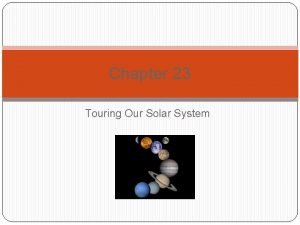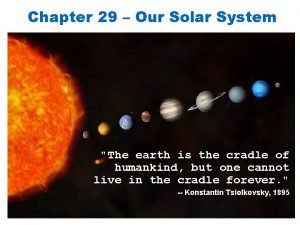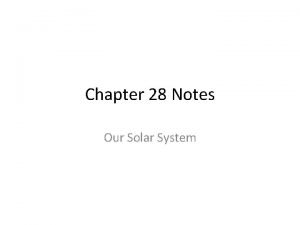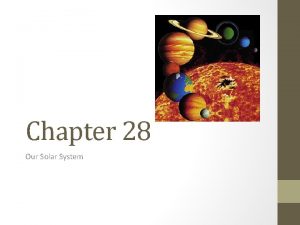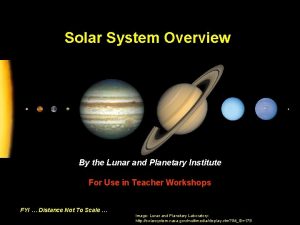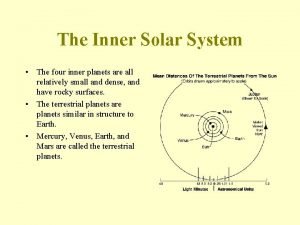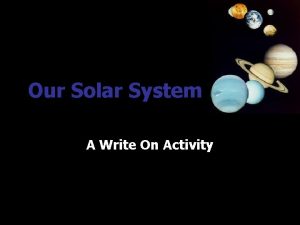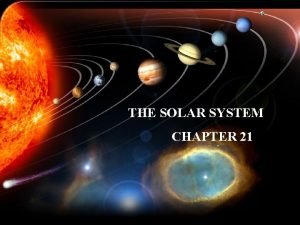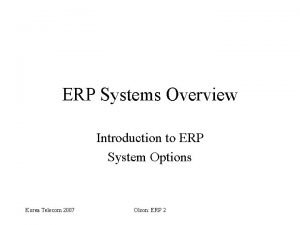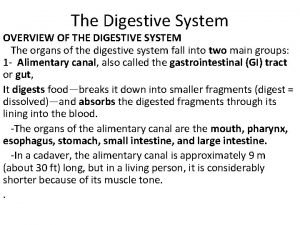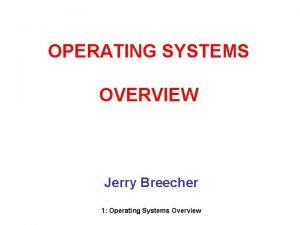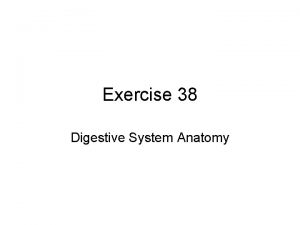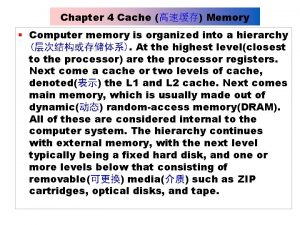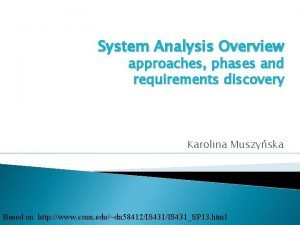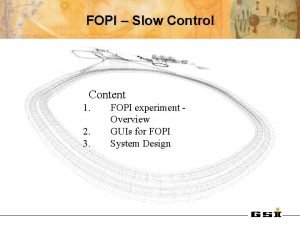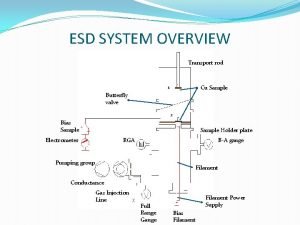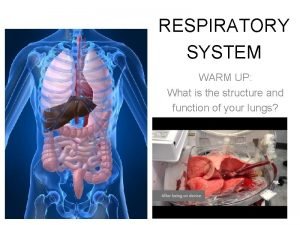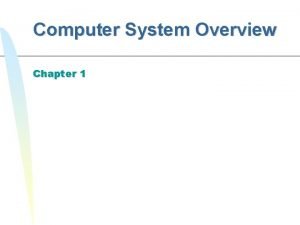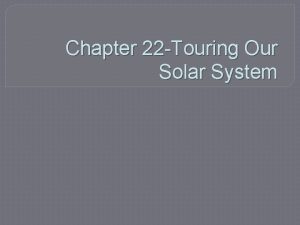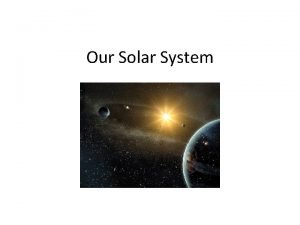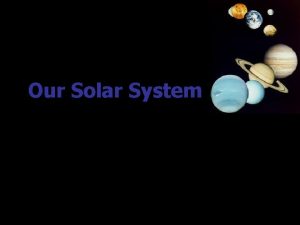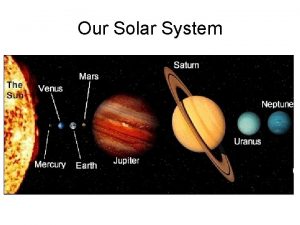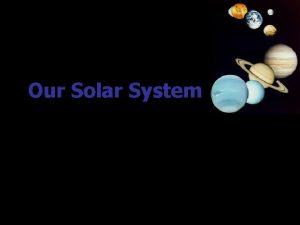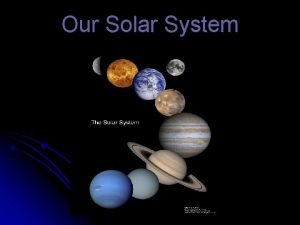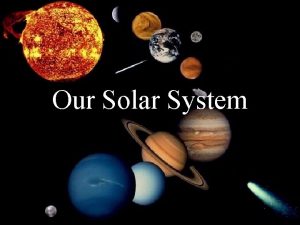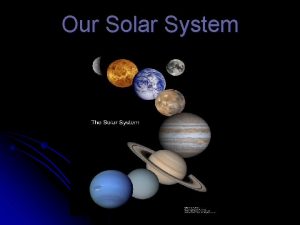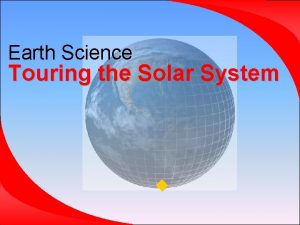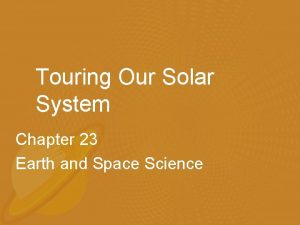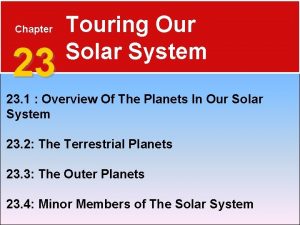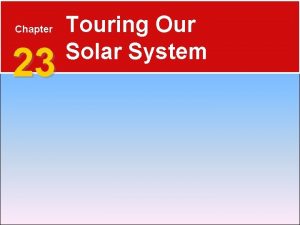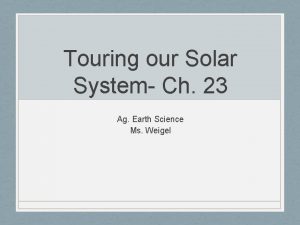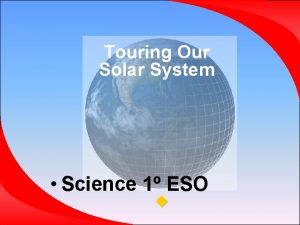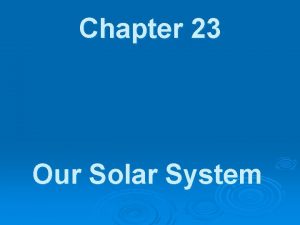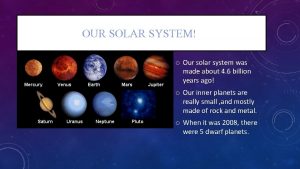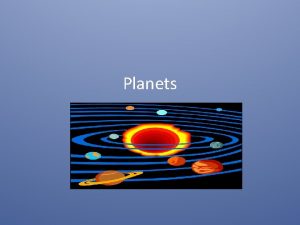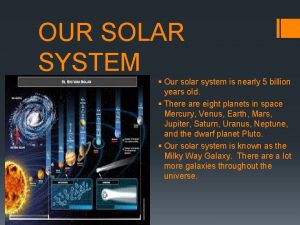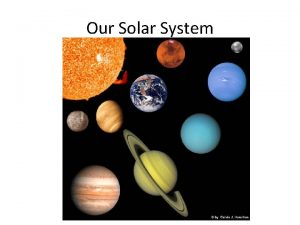Touring Our Solar System Chapter 22 Overview of






















































- Slides: 54

Touring Our Solar System Chapter 22

Overview of the solar system Solar system includes Sun Planets and their satellites Asteroids Comets Meteoroids

The solar system

Overview of the solar system A planet’s orbit lies in an orbital plane Similar to a flat sheet of paper The orbital planes of the planets are inclined Planes of seven planets lie within 3 degrees of the Sun’s equator Mercury’s is inclined 7 degrees

Overview of the solar system Two groups of planets occur in the solar system Terrestrial (Earth-like) planets Mercury through Mars Small, dense, rocky Low escape velocities Jovian (Jupiter-like) planets Jupiter through Neptune Large, low density, gaseous Massive Thick atmospheres composed of hydrogen, helium, methane, and ammonia High escape velocities

The planets drawn to scale

Overview of the solar system Planets are composed of Gases Hydrogen Helium Rocks Silicate minerals Metallic iron Ices Ammonia (NH 3) Methane (CH 4) Carbon dioxide (CO 2) Water (H 2 O)

Evolution of the planets Nebular hypothesis Planets formed about 5 billion years ago Solar system condensed from a gaseous nebula As the planets formed, the materials that compose them separated Dense metallic elements (iron and nickel) sank toward their centers Lighter elements (silicate minerals, oxygen, hydrogen) migrated toward their surfaces Process called chemical differentiation

Evolution of the planets Due to their surface gravities, Venus and Earth retained atmospheric gases Due to frigid temperatures, the Jovian planets contain a high percentage of ices

Earth’s Moon General characteristics Diameter of 3, 475 kilometers (2, 150 miles) is unusually large compared to its parent planet Density 3. 3 times that of water Comparable to Earth’s crustal rocks Perhaps the Moon has a small iron core

Earth’s Moon General characteristics Gravitational attraction is one-sixth of Earth’s No atmosphere Tectonics no longer active Surface is bombarded by micrometeorites from space which gradually makes the landscape smooth

Telescopic view of the Moon

Earth’s Moon Lunar surface Two types of terrain Maria (singular, mare), Latin for “sea” Dark regions Fairly smooth lowlands Originated from asteroid impacts and lava flooding the surface Highlands Bright, densely cratered regions Make up most of the Moon Make up all of the “back” side of the Moon Older than maria

Earth’s Moon Lunar surface Craters Most obvious features of the lunar surface Most are produced by an impact from a meteoroid which produces Ejecta Occasional rays (associated with younger craters)

A 20 -kilometer-wide crater on the Moon

Earth’s Moon Lunar surface Lunar regolith Covers all lunar terrains Gray, unconsolidated debris Composed of Igneous rocks Breccia Glass beads Fine lunar dust “Soil-like” layer produced by meteoric bombardment

Earth’s Moon Lunar history Hypothesis suggests that a giant asteroid collided with Earth to produce the Moon Older areas have a higher density Younger areas are still smooth Moon evolved in three phases Original crust (highlands) As Moon formed, its outer shell melted, cooled, solidified, and became the highlands About 4. 5 billion years old

Earth’s Moon Lunar history Moon evolved in three phases Formation of maria basins Younger than highlands Between 3. 2 and 3. 8 billion years old Formation of rayed craters Material ejected from craters is still visible e. g. , Copernicus (a rayed crater)

Planets: a brief tour Mercury Innermost planet Second smallest planet No atmosphere Cratered highlands Vast, smooth terrains Very dense Revolves quickly Rotates slowly

A view of Mercury

Planets: a brief tour Venus Second to the Moon in brilliance Similar to Earth in Size Density Location in the solar system Shrouded in thick clouds Impenetrable by visible light Atmosphere is 97 percent carbon dioxide Surface atmospheric pressure is 90 times that of Earth’s

Planets: a brief tour Venus Surface Mapped by radar Features 80 percent of surface is subdued plains that are mantled by volcanic flows Low density of impact craters Tectonic deformation must have been active during the recent geologic past Thousands of volcanic structures

Computer generated view of Venus

Planets: a brief tour Mars Called the “Red Planet” Atmosphere 1 percent as dense as Earth’s Primarily carbon dioxide Cold polar temperatures (– 193º F) Polar caps of water ice, covered by a thin layer of frozen carbon dioxide Extensive dust storms with winds up to 270 kilometers (170 miles) per hour

Planets: a brief tour Mars Surface Numerous large volcanoes – largest is Mons Olympus Less-abundant impact craters Tectonically dead Several canyons Some larger than Earth’s Grand Canyon Valles Marineras – the largest canyon

Mons Olympus, an inactive shield volcano on Mars

Gullies and canyons on Mars

Planets: a brief tour Mars Surface “Stream drainage” patterns Found in some valleys No bodies of surface water on the planet Possible origins o Past rainfall o Surface material collapses as the subsurface ice melts Moons Two moons Phobos Deimos Captured asteroids

Planets: a brief tour Jupiter Largest planet Very massive 2. 5 times more massive than combined mass of the planets, satellites, and asteroids If it had been times larger, it would have been a small star Rapid rotation Slightly less than 10 hours Slightly bulged equatorial region

Structure of Jupiter’s atmosphere

Planets: a brief tour Jupiter Banded appearance Multicolored Bands are aligned parallel to Jupiter’s equator Generated by wind systems Great Red Spot In planet’s southern hemisphere Counterclockwise rotating cyclonic storm

Planets: a brief tour Jupiter Structure Surface thought to be a gigantic ocean of liquid hydrogen Halfway into the interior, pressure causes liquid hydrogen to turn into liquid metallic hydrogen Rocky and metallic material probably exists in a central core

Planets: a brief tour Jupiter Moons At least 28 moons Four largest moons Discovered by Galileo – called Galilean satellites Each has its own character o Callisto – outermost Galilean moon o Europa – smallest Galilean moon o Ganymede – largest Jovian satellite o Io – innermost Galilean moon and is also volcanically active

The Galilean moons

Planets: a brief tour Saturn Similar to Jupiter in its Atmosphere Composition Internal structure Rings Most prominent feature Discovered by Galileo in 1610 Complex

Planets: a brief tour Saturn Rings Composed of small particles (moonlets) that orbit the planet Most rings fall into one of two categories based on particle density Thought to be debris ejected from moons Origin is still being debated

Recent image of Saturn

Planets: a brief tour Saturn Other features Dynamic atmosphere Large cyclonic storms similar to Jupiter’s Great Red Spot Thirty named moons Titan – the largest Saturnian moon Second largest moon (after Jupiter’s Ganymede) in the solar system Has a substantial atmosphere

Planets: a brief tour Uranus and Neptune are nearly twins Rotates “on its side” Rings Large moons have varied terrains

Planets: a brief tour Neptune Dynamic atmosphere One of the windiest places in the solar system Great Dark Spot White, cirrus-like clouds above the main cloud deck Eight satellites Triton – largest Neptune moon Orbit is opposite the direction that all the planet’s travel Lowest temperature in the solar system (391º F)

Planets: a brief tour Neptune Triton – largest Neptune moon Atmosphere of mostly nitrogen with a little methane Volcanic-like activity Composed largely of water ice, covered with layers of solid nitrogen and methane

Minor members of the solar system Asteroids Most lie between Mars and Jupiter Small bodies – largest (Ceres) is about 620 miles in diameter Some have very eccentric orbits Many of the recent impacts on the Moon and Earth were collisions with asteroids Irregular shapes Origin is uncertain

The orbits of most asteroids lie between Mars and Jupiter

Minor members of the solar system Comets Often compared to large, “dirty snowballs” Composition Frozen gases Rocky and metallic materials Frozen gases vaporize when near the Sun Produces a glowing head called the coma Some may develop a tail that points away from Sun due to Radiation pressure and the solar wind

Orientation of a comet’s tail as it orbits the Sun

Minor members of the solar system Comets Origin Not well known Form at great distance from the Sun Most famous short-period comet is Halley’s comet 76 year orbital period Potato-shaped nucleus (16 km by 8 km)

Minor members of the solar system Meteoroids Called meteors when they enter Earth’s atmosphere A meteor shower occurs when Earth encounters a swarm of meteoroids associated with a comet’s path Meteoroids are referred to as meteorites when they are found on Earth

Minor members of the solar system Meteoroids are referred to as meteorites when they are found on Earth Types of meteorites classified by their composition Irons o Mostly iron o 5– 20 percent nickel Stony o Silicate minerals with o Inclusions of other minerals

Minor members of the solar system Meteoroids are referred to as meteorites when they are found on Earth Types of meteorites classified by their composition Stony-irons – mixtures Carbonaceous chondrites o Rare o Composition – simple amino acids and other organic material

Minor members of the solar system Meteoroids are referred to as meteorites when they are found on Earth Types of meteorites classified by their composition Carbonaceous chondrites o May give an idea as to the composition of Earth’s core o Give an idea as to the age of the solar system

Dwarf planets New class of planets Orbit the Sun Not the only objects to occupy their area of space Pluto is the prototype of this new category Located in the Kuiper belt – a band of icy objects found beyond the orbit of Neptune Currently 6 dwarf planets have been discovered in our solar system, including Pluto

Dwarf planets Pluto Not visible with the unaided eye Discovered in 1930 Now classified as a dwarf planet Moon (Charon) discovered in 1978 Charon is tidal locked Average temperature is – 210º C

Kuiper Belt vs The Oort Cloud The Kuiper Belt is a doughnut- The Oort Cloud is a spherical shaped ring, extending just beyond the orbit of Neptune from about 30 to 55 AU. Short-period comets (which take less than 200 years to orbit the Sun) originate in the Kuiper Belt. There may be are hundreds of thousands of icy bodies larger than 100 km (62 miles) and an estimated trillion or more comets within the Kuiper Belt. shell, occupying space at a distance between five thousand 100 thousand AU. Long-period comets (which take more than 200 years to orbit the sun) come from the Oort Cloud. The Oort Cloud may contain more than a trillion icy bodies.

End of Chapter 22
 Chapter 23 touring our solar system
Chapter 23 touring our solar system Touring mobilis verkeersinfo
Touring mobilis verkeersinfo Chapter 29 our solar system
Chapter 29 our solar system Chapter 28 our solar system
Chapter 28 our solar system Chapter 28 our solar system
Chapter 28 our solar system Solar system overview
Solar system overview The four inner planets
The four inner planets What are terrestrial planets made of
What are terrestrial planets made of Biggest planet in our solar system
Biggest planet in our solar system Write about our solar system
Write about our solar system Wholesale solar panel tracker
Wholesale solar panel tracker Solar energy is free. solar is inexhaustible
Solar energy is free. solar is inexhaustible Chapter 2 an overview of the financial system
Chapter 2 an overview of the financial system Http://www.nineplanets.org
Http://www.nineplanets.org Thinking affects our language, which then affects our:
Thinking affects our language, which then affects our: Our census our future
Our census our future Bernadette farrell christ, be our light
Bernadette farrell christ, be our light Marcus aurelius our life is what our thoughts make it
Marcus aurelius our life is what our thoughts make it We bow our hearts
We bow our hearts Our census our future
Our census our future Our life is what our thoughts make it
Our life is what our thoughts make it Money madness explanation
Money madness explanation Awareness of ourselves and our environment is:
Awareness of ourselves and our environment is: Awareness of ourselves and our environment is
Awareness of ourselves and our environment is God our father christ our brother
God our father christ our brother Our future is in our hands quotes
Our future is in our hands quotes Our awareness of ourselves and our environment
Our awareness of ourselves and our environment Our awareness of ourselves and our environment
Our awareness of ourselves and our environment Erp system introduction
Erp system introduction Content management system capabilities
Content management system capabilities What is computerized accounting information system
What is computerized accounting information system Overview of the digestive system
Overview of the digestive system Operative indicators in sap ps
Operative indicators in sap ps Operating systems overview
Operating systems overview Uml diagram for gym management system
Uml diagram for gym management system Duodenum
Duodenum Set associative mapping in cache memory
Set associative mapping in cache memory Computer memory system overview
Computer memory system overview British school system overview
British school system overview British school system overview
British school system overview System design
System design System design overview
System design overview System overview sample
System overview sample 3 lobes lung
3 lobes lung Computer system overview
Computer system overview Emt chapter 24 trauma overview
Emt chapter 24 trauma overview Chapter 14 medical overview
Chapter 14 medical overview Chapter 9 lesson 2 photosynthesis an overview
Chapter 9 lesson 2 photosynthesis an overview Chapter 12 selling overview
Chapter 12 selling overview Chapter 1 overview of verb tenses
Chapter 1 overview of verb tenses Overview of personal finance chapter 1
Overview of personal finance chapter 1 Tooth numbering system in usa
Tooth numbering system in usa Introduction to personal finance answers
Introduction to personal finance answers General features of animals
General features of animals Chapter 1 an overview of financial management
Chapter 1 an overview of financial management
